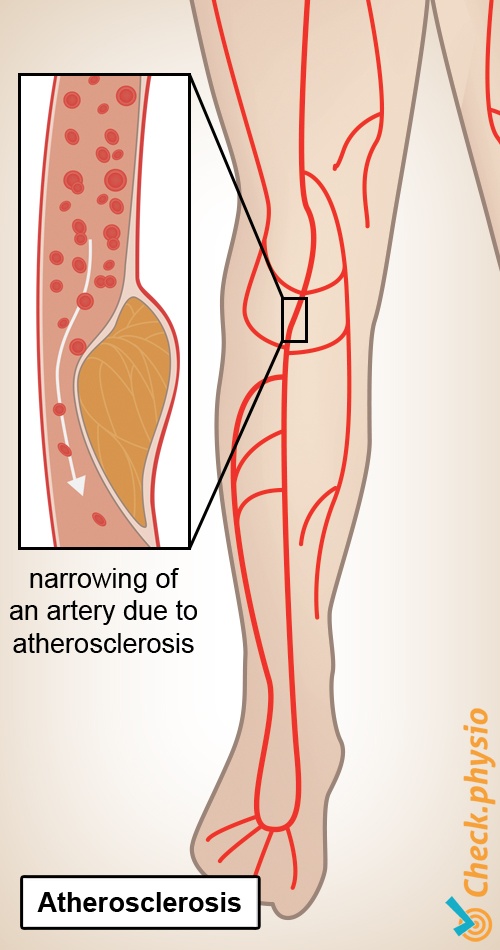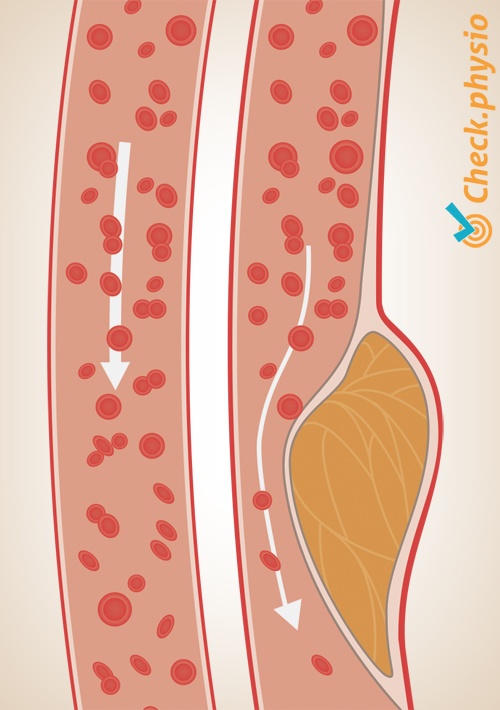- Conditions
- Intermittent claudication
Intermittent claudication Claudication intermittens / arterial intermittent claudication / arteriosclerosis of the blood vessels in the legs / peripheral arterial disease
Introduction
Intermittent claudication is a condition that affects the blood vessels. It is also known as "arterial intermittent claudication". The patient complains of pain in the legs that occurs while walking. The symptoms disappear when the patient stops walking, but start again after walking a similar distance to when the symptoms first started.
Arterial intermittent claudication mainly affects people over the age of 60. Only 1 in 2,500 people aged between 25 and 44 will develop this condition. The name "window-shopping legs" arose because people with these symptoms will often pause to look at a shop window when walking in a shopping street. In reality, they are stopping until the pain subsides. Pausing intermittently allows the pain to dissipate.

Description of condition
Arterial intermittent claudication is caused by a narrowing of the blood vessels in the leg due to atherosclerosis. Calcium deposits and fatty substances adhere to the inner wall of the arteries. We call this plaque formation. This reduces the blood flow to the leg. This condition is often (incorrectly) referred to as hardening of the arteries.
The plaques that remain in the arteries of the legs will accumulate there and can cause severe narrowing of the artery. This reduces the blood flow to the legs. In turn, the leg muscles do not receive enough oxygen when the patient walks, resulting in the symptoms of the condition.
Cause and history
Plaque formation is more common in people who smoke. There are various risk factors that can contribute to the development of the condition. For example, diabetes, high blood pressure and relative old age. In addition, men have a higher risk of arterial intermittent claudication.
Signs & symptoms
- Pain, cramping, or a tired feeling in the legs while walking or cycling.
- Standing still or resting reduces the symptoms.
- The symptoms occur after walking a set distance.
- The pain is usually present in the calf.
- The symptoms may also occur in the buttock region, the thigh, the sole of the foot and the toes.
- The foot of the affected leg may feel colder or become pale.
- The symptoms occur sooner when walking uphill.
- In severe cases the symptoms may also be present when at rest.
Diagnosis
The healthcare professional will first want to know what the complaints are, how long they have been present, and at what walking distance they occur. Then a physical examination follows where the pulse in the blood vessels of the leg is felt and the ankle-arm index is calculated. This is based on the blood pressure in the lower leg and arm. During a walking test, the maximum walking distance is measured before the complaints force the patient to stop.
Additionally, the blood flow can be assessed with an ultrasound. An X-ray with contrast fluid shows where any narrowing or widening of blood vessels is located. This contrast fluid is injected into the blood vessels before the examination.
Treatment and recovery
It is important for the patient to stop smoking. High blood pressure and diabetes need to be treated. The patient will be advised to exercise a lot and eat a healthy diet (reducing the consumption of saturated fatty acids).
The physiotherapeutic treatment consists of walking training for at least three months. In almost all cases this will result in an increase in the pain-free walking distance. The patient should walk for 15 - 30 minutes three times a day. The patient should continue walking a few additional yards after the pain occurs before stopping. Once the symptoms have dissipated, the patient should continue walking.
The narrowing of a blood vessel can be alleviated temporarily using surgery. However, this only makes sense if the patient changes their lifestyle.
More info
You can check your symptoms using the online physiotherapy check or make an appointment with a physiotherapy practice in your locality.
References
Nugteren, K. van & Winkel, D. (2008) Onderzoek en behandeling van spieraandoeningen en kuitpijn Houten: Bohn Stafleu van Loghum.
Jongert, M.W.A., Hendriks, H.J.M., Hoek, J. van, Klaasboer-Kogelman, K., Robeer, G.G., Simens, B., Voort, S. van der & Smit, B. (2003) KNGF-richtlijn claudicatio intermittens Nederlands Tijdschrift voor Fysiotherapie. Nummer 6, 2003.

